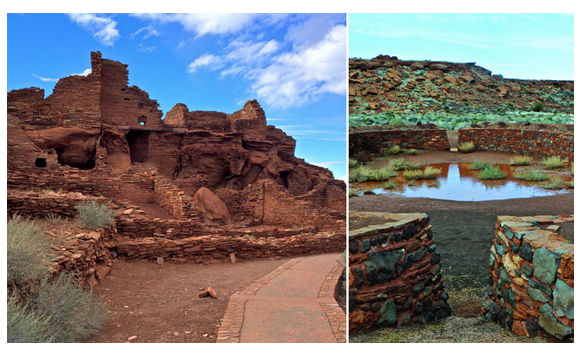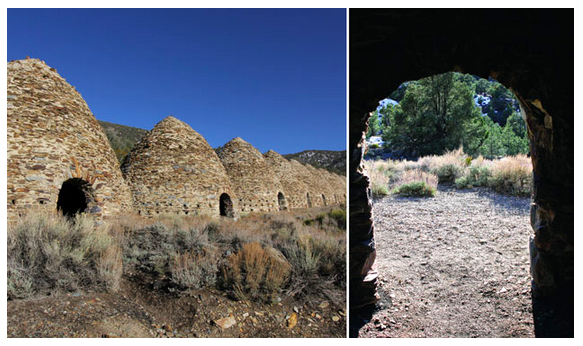
Premier Guitar just posted my latest Recording Guitarist column. The subject: Capturing the haunting reverbs of Southwestern ruins via impulse-response reverbs.
Many years ago I marveled at the eerie reflections within the stone-walled ball court at Wupatki, an hour north of Flagstaff, Arizona. On this visit, I attempted to clone the tone. I did the same at the Wildrose charcoal kilns in a remote, mountainous corner of Death Valley. The article includes audio clips, tech notes, and a download link for the impulse responses, suitable for use in any IR reverb program (or in the Logidy EPSi stompbox).

The 1870s charcoal kilns of Death Valley generate a spooky,, flange-like reverb.
Like a dope, I’d forgotten to bring the relatively high-quality recorder I’d intended to use, so I worked with noisy, lo-fi recordings from my iPhone 6’s Voice Memos app. After some digital cleanup (detailed in the article), the results were cool and compelling, though not a completely accurate audio snapshot due to various types of distortion.
(Actually, I had an earlier experience capturing quick-and-dirty reverbs when I visited the Neolithic caves of France and Spain last year. It wasn’t my idea—I just happened to wind up on a tour group with composer Craig Safan, who was conceptualizing a piece inspired by those evocative spaces. He’d packed a proper Zoom mobile recorder, and we made ad hoc impulse responses by clacking small stones together. Craig has since completed the work, Rough Magic, and he tells me his mixing engineer wound up using our IRs a great deal. I’ve heard the piece, and it’s awesome. It’s not public yet, but I’ll tell you when it is.)
Since writing this Premier Guitar piece, I’ve been pondering whether damaged/distorted impulse response files might be an interesting avenue for sonic exploration. Generating cool sounds via weird IRs isn’t a new idea—the Space Designer plug-in in Apple’s Logic Pro includes a little-known IR preset folder titled “Warped,” which uses unusual sources like synth tones and noise bursts to generate reverbs not found in nature. But my interests are reverbs that are both familiar and surreal—the echoes of distorted reality.
And coincidentally, just as I was writing this post, a friend sent this wonderful video: an old Teletubbies clip, processed through a smeary, distorted black-and-white filter and paired with Joy Division’s “Atmosphere.”
I’m pretty much talking about an audio equivalent to that video processing. Has anyone else thought about or explored this idea?








Oh — my friend Ros, who sent me the Teletubbies video, also sent this. It has no bearing on the topic whatsoever—it’s just awesome.
I used to use a spring loaded clipboard to create really loud and repeatable impulses for casual investigation of architectural spaces on campus. That was before the days of portable digital recorders. Allowed me to estimate reverb time by counting seconds until I couldn’t hear it, and really brought out things like parallel wall flutter echoes, etc. Probably a good idea to fire it off behind the back. Plus you get to look all scientific and stuff when you’re carrying it around.
Not only was that a great idea back then – I bet it still is! The “real” way to make IR reverbs is by playing a sine-sweep through hi-fi speakers within the target space, or using a track-meet starter pistol. While it’s a miracle to me that inconsistent hand-claps and rock-clacks work, I bet that spring-loaded clack would be far more effective. I’m totally going to try that—thanks! 🙂
The challenge, as with cowbells, is to get one with a nice tone. If you do, however, you can look forward to cries for “More clipboard!” at your next gig.
Ha! Possibly the strangest request I’ve heard was for more pitchfork. “non-musical” stuff in the right context is beautiful.
Thanks for making this stuff available Joe. I can’t wait to try these IRs in the EPSi.
The download includes both AIFF and WAV files. EPSi requires WAVs (or at least it did — I don’t know whether there have been any firmware updates). Anyway, just pop in the WAVs. 🙂
I was gonna try them out today and got sidetracked…hopefully I can make time tomorrow. I should probably check for firmware updates for the EPSi while I’m at it. One thing I would really love to see is support for SDHC cards- it’s getting harder to find the smaller capacity “old school” SD cards and they seem kind of relatively expensive anymore.
I use a Logidy and convultions – I've used yours! in my live-looping setup. I have all output going to the monitor speakers through the logidy, from a mix of several out of phase loops (syzygy looping of Hohner Pianet and Guitaret) and a collage of field recordings. I was inspired to do this by your column on the cave reverb and your review of the Logidy pedal. So I am indebted to you for both informing me and inspiring me. Thanks!
Here is my latest effort in this style.
https://www.youtube.com/watch?v=aBVok8lONh0
Yes Joe, great idea
Are you familiar with iOS music apps (for iPad) that do this stuff
There is a particularly compelling one called GliderVerb by amazing noises that you can set up to Glissando between different verbs, as well as stuff like Flux, the Belew multi effector app, they also do a feedback delay network,
Mobile convolution reverb by Liquidsonics takes IRs, lots of fun!
Okay…I read this article about 3 months ago. In what other magazine was it published?